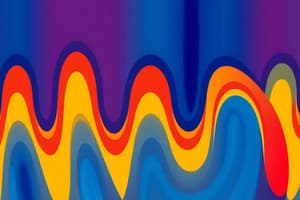Podcast
Questions and Answers
What is the formula used to calculate wave speed?
What is the formula used to calculate wave speed?
- Wave speed = frequency * wavelength (correct)
- Wave speed = wavelength / frequency
- Wave speed = 2 * frequency * wavelength
- Wave speed = frequency / wavelength
When a wave moves from a more dense medium to a less dense medium, its frequency decreases.
When a wave moves from a more dense medium to a less dense medium, its frequency decreases.
False (B)
If the frequency of a wave is 5Hz and it's wavelength is 2m, what is the wave speed?
If the frequency of a wave is 5Hz and it's wavelength is 2m, what is the wave speed?
10 m/s
Electromagnetic waves are classified as ______ waves.
Electromagnetic waves are classified as ______ waves.
Match the surface types with their expected infrared radiation emission based on the Leslie cube experiment:
Match the surface types with their expected infrared radiation emission based on the Leslie cube experiment:
What piece of equipment is used to generate waves on a string?
What piece of equipment is used to generate waves on a string?
Electromagnetic waves travel at different speeds in a vacuum.
Electromagnetic waves travel at different speeds in a vacuum.
What two values are used to measure the wavelength of any wave?
What two values are used to measure the wavelength of any wave?
Which of the following best describes a transverse wave?
Which of the following best describes a transverse wave?
Sound waves traveling through air are an example of transverse waves.
Sound waves traveling through air are an example of transverse waves.
What is the distance from a point on one wave to the same point on the next wave called?
What is the distance from a point on one wave to the same point on the next wave called?
The time taken for a full wave to pass a given point is called the ______.
The time taken for a full wave to pass a given point is called the ______.
Match the wave terms to their descriptions:
Match the wave terms to their descriptions:
What formula is used to calculate the period of a wave?
What formula is used to calculate the period of a wave?
When measuring the speed of sound using an echo, why is it important to measure multiple times?
When measuring the speed of sound using an echo, why is it important to measure multiple times?
When a wave travels through a medium, the matter itself moves with the wave.
When a wave travels through a medium, the matter itself moves with the wave.
Flashcards
Amplitude
Amplitude
The maximum displacement of a particle from its rest position in a wave.
Wavelength
Wavelength
The distance between two corresponding points on adjacent waves.
Frequency
Frequency
The number of waves that pass a given point in one second.
Period
Period
Signup and view all the flashcards
Transverse Wave
Transverse Wave
Signup and view all the flashcards
Longitudinal Wave
Longitudinal Wave
Signup and view all the flashcards
Compression
Compression
Signup and view all the flashcards
Rarefaction
Rarefaction
Signup and view all the flashcards
Waves in a String
Waves in a String
Signup and view all the flashcards
Frequency of a Wave
Frequency of a Wave
Signup and view all the flashcards
Wavelength of a Wave
Wavelength of a Wave
Signup and view all the flashcards
Wave Speed
Wave Speed
Signup and view all the flashcards
Wave Speed Equation
Wave Speed Equation
Signup and view all the flashcards
Electromagnetic Waves
Electromagnetic Waves
Signup and view all the flashcards
Electromagnetic Spectrum
Electromagnetic Spectrum
Signup and view all the flashcards
Study Notes
Waves
- Waves transfer energy, not matter
- Transverse waves: particles vibrate perpendicular to energy transfer (e.g., water waves, EM waves)
- Longitudinal waves: particles vibrate parallel to energy transfer (e.g., sound waves)
- Amplitude: distance from undisturbed position to peak/trough
- Wavelength: distance between corresponding points on adjacent waves
- Frequency: number of waves passing a point per second (Hertz)
- Period: time taken for one complete wave to pass a point (seconds)
- Wave speed: speed of energy transfer through a medium (meters per second)
- Wave speed = frequency × wavelength
Ripple Tank Practical
- Apparatus: ripple tank, dipper, light source, white paper, ruler, strobe
- Measuring wavelength: measure length of 10 waves and divide by 10, repeat and find mean
- Measuring frequency: count number of waves passing a point in 10 seconds and divide by 10, repeat and find mean.
- Calculating wave speed: wave speed = frequency × wavelength
Waves in Solids
- Apparatus: signal generator, string, pulley, masses, metre ruler
- Measuring wavelength: count half wavelengths in 1m, divide 1m by the number of half wavelengths and double the result.
- Frequency = signal generator frequency
- Wave speed = frequency × wavelength
Electromagnetic Spectrum
- Electromagnetic waves are transverse
- Travel at the same speed in a vacuum
- Grouped by frequency and wavelength
- Radio waves, microwaves, infrared, visible light, ultraviolet, x-rays, gamma rays
- Remember: Roman Men Invented Very Unusual X-ray Guns
- Properties of Electromagnetic Waves: refraction (bending of a wave when it enters a different medium),
- Greater density = slower speed, bends towards the normal. Lesser density = faster speed, bends away from the normal.
Electromagnetic Wave Uses and Applications
- Radio waves: terrestrial television/radio
- Microwaves: satellite communication, heating food, thermal imaging
- Infrared: cooking, thermal imaging, remote controls, fibre optics
- Visible light: vision, fibre optics, lamps
- Ultraviolet: tanning, detecting forged banknotes, sterilising
- X-rays: medical imaging, airport security
- Gamma rays: medical imaging, cancer treatment, sterilising.
Properties of Electromagnetic Waves
- Different substances absorb, reflect, refract or transmit EM waves differently, these properties depend on the wavelength.
Required Practical: Radiation and Absorption
- Investigate how surfaces affect infrared absorption and emission using a Leslie cube, infrared detector, and different surfaces.
- Dark, matt surfaces emit more infrared radiation than light, shiny surfaces.
Studying That Suits You
Use AI to generate personalized quizzes and flashcards to suit your learning preferences.




